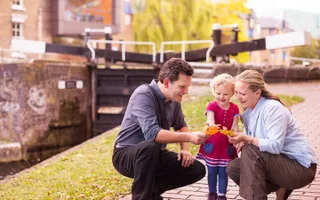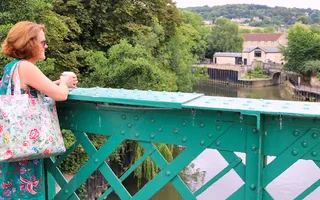By Lucy Anna Scott
These places might be a brightly coloured art exhibition on a miserable day, the city's parks in the early morning light or being carried away on the melodies of live music. But of all the escape routes I know, it is London's waterways I most cherish.
They are paths to a better place, both physical and imaginary. I flee to the city's rivers to drown out the din of the metropolis but to rediscover it too. Being near the city's water enables me to see and feel it anew, to rekindle my romance with a place that can often be tough to love.
Like the metropolis they inhabit, the waterways I meet are diverse in personality. I can seek out water that is fast flowing or still, mysteriously muddy or as clear as crystal and light streaked. To connect with Mother Nature, I will stand aside a tidal waterway to tune into the cycle of the Moon; to be alone, I will walk a river path frothing with buddleia and marsh.
Escape the pavements
Wherever I choose to be, the city's waterways soften and loosen my sense of the urban geography. Too often the daily grind requires us to journey the city by pounding the streets. At such times it is easy to forget there is much more to the environment and that being a city-dweller doesn't mean being alienated from a bluer, and greener, world. Observing the myriad nature of London's waterways reconnects me with the knowledge that the city is a textured place – one that is both wild and man-made.
Open a map of London and you'll observe blue lines drizzled east to west and north to south. These represent over a hundred kilometres of waterway; canals and rivers that present the city in fresh perspectives. Tracing these on foot, or bike, reveals a city in possession of weeping willows, kingfishers and dragonflies, floating art galleries and gothic graveyards. You'll see shelducks in the waters by Greenland Pier and freshwater plants on the banks of the river in Putney.
The mightiest beast is obviously the Thames, whose biting waters whip and rip through the body of the city. Watching the Thames flow I am reacquainted with the power of the natural world and the idea that the city encompasses chalk streams, creeks, clay and heathland, and many other wild spaces besides. I think of the layers of geological epochs under my feet, and the metropolis as a flimsy empire perched on it. It is a bracing lesson in the briefness of our own time and the duty to make the most of our moments.
The introverted Londoner Water has also led me to many a Londoner whose urban life is shaped by its rivers and canals, made unique and special by them. Among the most memorable was a winemaker who grew his exotic grapevines by an East End canal due to the warm microclimate the water conjured in that spot. Then there were the volunteers who staff RNLI lifeboats, in all weathers, between Barking Creek and Battersea, to break with their mundane, sedentary jobs. And the artist who takes his paints and canvas to the foreshore of the Thames at dawn to capture the muddied riverbed as it appears with retreating tide.
These characters know that we do not need a sea view to allow water to heal us. When worn out by the incessant chatter of the metropolis – as I often am – eyeing the arc of a bird as it dives into its waters by Waterloo Bridge takes me elsewhere and frees my mind from its net of anxieties. When I see a neighbourhood of canal boats bobbing on the water, adorned with festoon lights and cheerful rooftop gardens, I am reminded of the need to let the boat of life be light. When I stroll aside the gentle River Lee and its backwaters I find a great companion, the kind you can travel alongside without having to say a word.
London's waterways meander through some of the most central parts of the city, too. There's the historic Regent's Canal, which pulses through King's Cross, a district criss-crossed by rail tracks and swanky buildings. Here the canal slinks past a public square built around lively water jets and deck chairs. Amid the hard edges of Zone 1, water exists here at its most humanising and liberating.
After all, we have more in common with the elements than we do with concrete and bricks. Water is part of us, an essential and major component of our physiology. And so, I believe, it helps us feel at home – in ourselves, in a landscape – whatever kind of landscape, and whether it is a thrusting river or an ancient fountain. So even on those days when I am drudging dull pavements as the rain pelts and soaks me to the skin, I know that somewhere in the city, below the sirens and the soundtrack of impatient traffic, somewhere very close by, there are countless raindrops plopping into a lido, a canal or vast park lake; making quiet, soft ripples across all those undulating lines of blue.
Lucy Anna Scott's book ‘Mindful Thoughts for City Dwellers: The Joy of Urban Living (Leaping Hare Press)' came out 1 March 2018.






